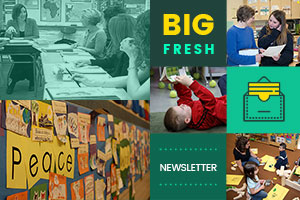Most of us can easily do two things at once; what’s all but impossible is to do one thing at once.
Mignon McLaughlin
This winter I started hosting a student teacher in our fifth-grade classroom. Looking for some guidance, Katie asked what she should focus on first. Without any hesitation I replied, “Build relationships with the students. Everything else is secondary.”
I know she was puzzled that I emphasized getting to know the kids. I explained that the relationships she has with students are the foundation for everything. The bond teachers have with children makes the rest of the work easier by default. You have to know what makes each child tick.
To illustrate this point, I shared with her a story about a boy I had taught three years before. We can call him John. John was a kind and silly fifth grader. He loved football, video games, and his friends. What John did not love was work. Effort on the football field? You bet. Effort in the classroom? No thanks. This drove me a bit mad all year long, but we persevered. I adored John, for all of his quirks.
John struggled with spelling, even though he was a talented reader. One word in particular seemed to be his nemesis, the word so. You would think that by fifth grade John would have mastered so. I would have thought the same. Yet time and time again, he spelled it sowe. I don’t know where the two extra letters came from. He did draw the word out whenever he said it, which may have caused confusion about the word’s length. For example, if asking me a question he would say, “Soooooo, Mrs. S., are we going to have read aloud now?” In almost every draft he wrote, sowe would stare back at me multiple times.
I mentioned sowe often in conferences. Each time I reminded him of the correct spelling, he’d drop his head in his hands and wonder aloud why he couldn’t remember. It wasn’t until March that I broke through. We were sitting side by side looking over his writing. I saw sowe throughout his narrative. I circled it, looked at John, and smiled. Knowing this boy so well by this point of the year, I threw my arm across his shoulders and asked if he knew I adored him. He smiled and nodded. Then I proceeded.
“John, you can be a bit lazy in the classroom, right? Would you agree?”
He glanced up at me, saw I was smiling, and his grin stretched across his face. He nodded in agreement.
I looked from his journal to him. “So why are you doing double the work each time you write so? Four letters versus two? Seems crazy to me.”
John looked back down at his notebook, then back at me. “You’re right!”
From March until the end of the year, so was spelled correctly every single time in John’s writing. Every time he used that word, I smiled as I remembered that conference and the breakthrough.
When I finished the story I looked at Katie, my student teacher, and said, “Do you see why relationships are vital? I couldn’t have that conversation with many children, and it wouldn’t work with any child without trust.” Katie understood. By the end of three weeks, she knew each of the 80 kids we teach. She conferred, read their writing, and learned what their interests were. She is well on her way to becoming a fine teacher.
This week we look at time constraints in classrooms. Plus more as always — enjoy!
Katherine Sokolowski
Contributor, Choice Literacy
Katherine Sokolowski has taught for over 15 years in elementary schools, and currently teaches fifth grade in the same small town in central Illinois where she grew up. She regularly writes about teaching on her blog Read Write Reflect.
Free for All
[For sneak peeks at our upcoming features, quotes and extra links, follow Choice Literacy on Twitter: @ChoiceLiteracy or Facebook: http://www.facebook.com/ChoiceLiteracy or Pinterest: http://pinterest.com/choiceliteracy/]
Here are two features from the archives on time and balance.
In this quick-take video, Aimee Buckner talks about time constraints in conferences:
http://www.choiceliteracy.com/articles-detail-view.php?id=578
Kelly Petrin explains how she balances the demands of teaching and a personal life in SPREAD:
http://www.choiceliteracy.com/articles-detail-view.php?id=1820
Elena Aguilar shares strategies to help teachers say “no” more often, so that time can be preserved for the work that matters most:
World Read Aloud Day is March 4th! You can find details on how to participate here:
For Members Only
Ruth Ayres provides a ready reference guide for the typical length of everything from a minilesson to a conferring session in How Long?:
http://www.choiceliteracy.com/articles-detail-view.php?id=2148
Maria Caplin explains how a Digital Status of the Class saves minutes every week that add up to extra hours of instructional time over the year:
http://www.choiceliteracy.com/articles-detail-view.php?id=2056
In this week’s video, Leslie Lloyd preserves instructional time by having her third-grade students share their Post It Prove It notes on a bulletin board throughout the reading workshop:
http://www.choiceliteracy.com/articles-detail-view.php?id=1722
Gigi McAllister gives suggestions for finding pockets of time in overstuffed schedules:
http://www.choiceliteracy.com/articles-detail-view.php?id=2168
In an encore video, Katie Doherty talks about using timers in middle school workshops:
http://www.choiceliteracy.com/articles-detail-view.php?id=683
That’s all for this week!



